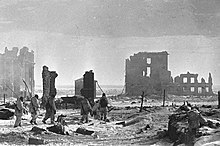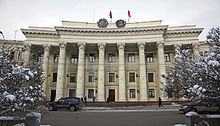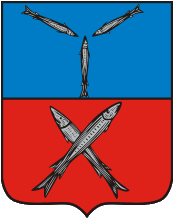Volgograd City (Волгоград)
|
Volgograd on a 1979 map |
Kazan Cathedral |
Building of the Oblast Duma |
Volgograd
On May 21, 2007, the Communist Party obtained an important success in the Volgograd mayoral election. Communist candidate Roman Grebennikov was elected as mayor with 32.47% of the vote. Grebennikov is Russia's youngest mayor of a federal subject administrative center.
In 2010, Russian monarchists and leaders of the Orthodox organizations demanded that the city should return to its original name Tsaritsyn, but the authorities rejected their proposal.
On January 30, 2013, the Volgograd City Council passed a measure to use the title "Hero City Stalingrad" in city statements on nine specific dates annually. On the following dates the title "Hero City Stalingrad" can officially be used in celebrations:
- February 2 (end of the Battle of Stalingrad),
- February 23 (Defender of the Fatherland Day),
- May 9 (Victory Day),
- June 22 (start of Operation Barbarossa),
- August 23 (start of the Battle of Stalingrad),
- September 2 (Victory over Japan Day),
- November 19 (start of Operation Uranus),
- December 9 (Day of the Fatherland's Heroes)
In addition, 50,000 people signed a petition to Vladimir Putin, asking that the city's name be permanently changed to Stalingrad. President Putin has replied that such a move should be preceded by a local referendum and that the Russian authorities will look into how to bring about such a referendum.
|
|
Volgograd International |
Volgograd Metro-tram |
|
Coat of Arms of Tsaritsyn (1857)

City map of Tsaritsyn (1909)

General Pyotr Wrangel in Tsaritsyn, 15 October 1919

Center of Stalingrad after liberation in 1942

Volga River in Volgograd
|
TsaritsynAlthough the city may have originated in 1555, documented evidence of Tsaritsyn at the confluence of the Tsaritsa and Volga rivers dates only from 1589. Grigori Zasekin established the fortress Sary Su (the local Tatar-language name means "yellow water" or "yellow river") as part of the defences of the unstable southern border of the Tsardom of Russia. The structure stood slightly above the mouth of the Tsaritsa River on the right bank. It soon became the nucleus of a trading settlement. In 1607 the fortress garrison rebelled against the troops of Tsar Vasili Shuisky for six months. In 1608 the city acquired its first stone church, St. John the Baptist. At the beginning of the 17th century, the garrison consisted of 350 to 400 people. In 1670 troops of Stepan Razin captured the fortress; they left after a month. In 1708 the insurgent Cossack Kondraty Bulavin (died July 1708) held the fortress. In 1717 in the Kuban pogrom, raiders from the Kuban under the command of the Crimean Tatar Bakhti Gerai blockaded the town and enslaved thousands in the area. In August 1774 Yemelyan Pugachev unsuccessfully attempted to storm the city. In 1691 Moscow established a customs-post at Tsaritsyn. In 1708 Tsaritsyn was assigned to the Kazan Governorate; in 1719 to the Astrakhan Governorate. According to the census in 1720, the city had a population of 408 people. In 1773 the city became a provincial and district town. From 1779 it belonged to the Saratov Viceroyalty. In 1780 the city came under the newly-established Saratov Governorate. In the 19th century Tsaritsyn became an important river-port and commercial center. The population expanded rapidly, increasing from fewer than 3,000 people in 1807 to about 84,000 in 1900. The first railway reached the town in 1862. The first theatre opened in 1872, the first cinema in 1907. In 1913 Tsaritsyn got its first tram-line, and the city's first electric lights were installed in the city center. During the Russian Civil War of 1917–1923, Tsaritsyn came under Soviet control from November 1917. In 1918 White troops under the Ataman of the Don Cossack Host, Pyotr Krasnov, besieged Tsaritsyn. The Reds repulsed three assaults by the Whites. However, in June 1919 the White Armed Forces of South Russia under the command of General Denikin captured Tsaritsyn, which they held until January 1920. The fighting from July 1918 to January 1920 became known as the Battle for Tsaritsyn. StalingradThe city was renamed Stalingrad after Joseph Stalin on April 10, 1925. This was officially to recognize the city and Stalin's role in its defense against the Whites between 1918 and 1920. In 1931, the German settlement-colony Old Sarepta (founded in 1765) became a district of Stalingrad. Renamed Krasnoarmeysky Rayon (or "Red Army District"), it became the largest area of the city. The first institute was opened in 1930. A year later, the Stalingrad Industrial Pedagogical Institute, now Volgograd State Pedagogical University, was opened. Under Stalin, the city became a center of heavy industry and transshipment by rail and river. During World War II, German and Axis forces attacked the city, and in 1942 it became the site of one of the pivotal battles of the war. The Battle of Stalingrad had perhaps the greatest casualty figures of any single battle in the history of warfare (estimates are between 1,250,000 and 1,798,619). The battle began on August 23, 1942, and on the same day, the city suffered heavy aerial bombardment that reduced most of it to rubble. By September, the fighting reached the city center. The fighting was of unprecedented intensity; the city's central railway station changed hands thirteen times, and the Mamayev Kurgan (one of the highest points of the city) was captured and recaptured eight times. By early November, the German forces controlled 90 percent of the city and had cornered the Soviets in two narrow pockets, but they were unable to eliminate the last pockets of Soviet resistance before Soviet forces launched a huge counterattack on November 19. This led to the encirclement of the German Sixth Army and other Axis units. On January 31, 1943 the Sixth Army's commander, Field Marshal Friedrich Paulus, surrendered, and by February 2, with the elimination of straggling German troops, the Battle of Stalingrad was over. In 1945 the Soviet Union awarded Stalingrad the title Hero City for its resistance. Great Britain's King George VI awarded the citizens of Stalingrad the jeweled "Sword of Stalingrad" in recognition of their bravery. A number of cities around the world (especially those that had suffered similar wartime devastation) established sister, friendship and twinning links (see list below) in the spirit of solidarity or reconciliation. One of the first "sister city" projects was that established during World War II between Stalingrad and Coventry in the United Kingdom – both suffered extensive devastation from aerial bombardment. |
| Source: Wikipedia.org |










